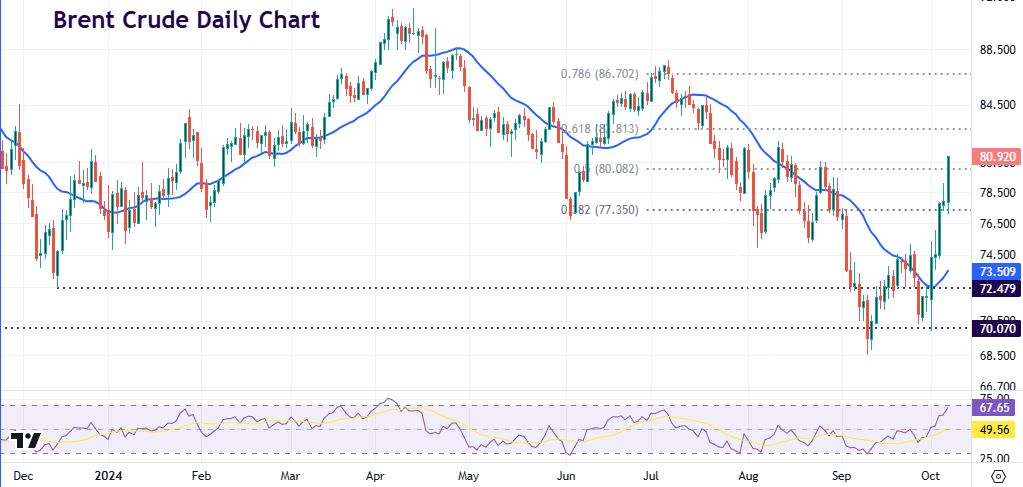Stocks retreat, oil jumps amid continued Middle East tensions

* Crude extends gains on Middle East worries and Hurricane Milton
* US yields back at 4% for first time since August on Fed rethink
* Dollar bobs near 7-week high after strongest week in two years
* Stocks fall on weak risk mood amid higher yields and geopolitics
FX: USD closed unchanged on the session, consolidating its recent win streak after making gains every day last week. Friday’s blockbuster US jobs report put paid to another 50bps Fed rate cut in the near term. As we said in our weekly preview, market pricing is now in line with the Fed’s median dot plot of two 25bps moves. Inflation data is the major data point this week, though the FOMC’s focus is now on employments figures.
EUR manged to steady itself with a first day in the green since Thursday, September 26. The ECB is set to cut rates again next week, which wasn’t on the cards just a few weeks ago. Soft inflation and ongoing stagnation have helped the doves, with only ECB speakers on the wires to look out for this week. But EZ/US yields spreads won’t likely tighten materially to upset more policy easing on October 17.
GBP dipped for a fifth straight day, falling below 1.31. Next support in cable is around 1.30 with a major Fib level, plus the July high and September low. BoE Chief Economist Huw Pill offered GBP a lifeline on Friday, as he warned against cutting too aggressively. There’s little data out this week, apart from Friday’s backward-looking GDP figures. But we do get wage growth and CPI next week which could see volatility.
USD/JPY moved lower as the yen was a clear outperformer on the day. JPY had one of its weakest weeks since 2009 last week. Volatility in the JPY has picked up causing finance minister Kato to say that these wild swings are negative for Japanese companies and households.
AUD sold off for a third day in a row. Risk off sentiment saw the Antipodeans have the worst day among the majors. USD/CAD popped up to the first major retracement level of the August to October decline at 1.3631. Firmer oil prices didn’t offset stock market weakness.
US Stocks traded lower with tech leading most of the losses. The VIX closed at its highest point since the start of August. The S&P 500 closed 0.83% lower to settle at 5,751. The tech-laden Nasdaq 100 lost 1.17% to finish at 19,800. The Dow settled down 0.94% at 41,954. Energy again outperformed as the only sector in positive territory. Nvidia saw notable gains while Super Micro surged nearly 16% after it said it recently deployed more than 100k GPUs in one quarter. Israel’s response to last week’s Iran missile attack is said to be imminent, according to Israeli media reports.
Asian stocks: Futures are in the red. Asian stocks were higher following the strong lead from Friday’s hot US labour market data. The ASX 200 saw tech and financials strength offset defensives weakness. The Nikkei 225 gapped above 39,000 on yen weakness. The Hang Seng climbed ahead of the mainland resuming trading. Chinese authorities will also hold a press conference today where officials will provide an update on the implementation of the recently announced measures to support the economy.
Gold dipped again modestly for a fourth consecutive day. Near-term support at last Monday’s low of $2624. The 10-year US Treasury yield moved above 4% as yields continue to rise and reduce rate cut bets. There are now 49bps of easing priced in for this year, compared to above 70bps a week or so ago.
Chart of the Day – Oil still bid
Oil prices cotinued to move higher, having rallied more than 8% last week. That was the strongest weekly gain since March 2023. Hurricanes and primarily geopolitical tensions in the Middle East have ramped up, with Israel making it clear they will strike Iran after the country launched a missile attack last Tuesday. Depending on the scale of the Israeli response, it could potentially be significant for oil markets. This is not only due to the immediate impact of losing Iranian barrels. But also down to escalation spilling over into something more extreme, which could potentially lead to a disruption in Persian Gulf oil and LNG flows through the Strait of Hormuz.
Iran produces roughly 1.7million b/d so that loss would be enough to push the global market back into a sizeable deficit from Q4 through 2025. OPEC+ could then gradually unwind 2.2m b/d of additional voluntary cuts. The Strait of Hormuz is certainly the biggest issue. A third of all seabourne oil moves through there, so 14 million b/d of oil supply at risk. There could also be potential LNG disruption from Qatar which has 20% of global LNG trade. Brent prices broke through the 50% retracement of the April to September sell-off at $80.08. Next resistance is $82.81, then $86.70 and $91.65, with support around $80.

The information has been prepared as of the date published and is subject to change thereafter. The information is provided for educational purposes only and doesn't take into account your personal objectives, financial circumstances, or needs. It does not constitute investment advice. We encourage you to seek independent advice if necessary. The information has not been prepared in accordance with legal requirements designed to promote the independence of investment research. No representation or warranty is given as to the accuracy or completeness of any information contained within. This material may contain historical or past performance figures and should not be relied on. Furthermore estimates, forward-looking statements, and forecasts cannot be guaranteed. The information on this site and the products and services offered are not intended for distribution to any person in any country or jurisdiction where such distribution or use would be contrary to local law or regulation.
